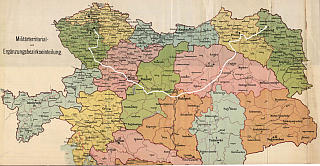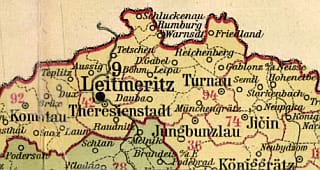
Švejk's journey on a of Austria-Hungary from 1914, showing the military districts of k.u.k. Heer. The entire plot of The Good Soldier Švejk is set on the territory of the former Dual Monarchy.
The Fateful Adventures of the Good Soldier Švejk (mostly known as The Good Soldier Švejk) by Jaroslav Hašek is a novel that contains a wealth of geographical references - either directly through the plot, in dialogues or in the author's narrative. Hašek was himself unusually well travelled and had a photographic memory of geographical (and other) details. It is evident that he put a lot of emphasis on geography: Eight of the 27 chapter headlines in the novel contain geographical names.
This web site will in due course contain a full overview of all the geographical references in the novel; from Prague in the introduction to Klimontów in the unfinished Part Four. Continents, states (also defunct), cities, market squares, city gates, regions, districts, towns, villages, mountains, mountain passes, oceans, lakes, rivers, caves, channels, islands, streets, parks and bridges are included.
The list is sorted according to the order in which the names appear in the novel. The chapter headlines are from Zenny Sadlon's recent translation (1999-2024) and will in most cases differ from Cecil Parrott's translation from 1973.
The quotes in Czech are copied from the on-line version of The Good Soldier Švejk: provided by Jaroslav Šerák and contain links to the relevant chapter. The toolbar has links for direct access to Wikipedia, Google maps, Google search, svejkmuseum.cz and the novel on-line.
The names are coloured according to their role in the novel, illustrated by these examples: Sanok a location where the plot takes place, Dubno mentioned in the narrative, Zagreb part of a dialogue, and Pakoměřice mentioned in an anecdote.
 Places index of countries, cities, villages, mountains, rivers, bridges ... (592)
Show all
Places index of countries, cities, villages, mountains, rivers, bridges ... (592)
Show all I. In the rear
I. In the rear  14. Švejk as military servant to senior lieutenant Lukáš (60)
14. Švejk as military servant to senior lieutenant Lukáš (60) II. At the front
II. At the front  2. Švejk's budějovická anabasis (64)
2. Švejk's budějovická anabasis (64) 3. Švejk's happenings in Királyhida (43)
3. Švejk's happenings in Királyhida (43) III. The famous thrashing
III. The famous thrashing  1. Across Magyaria (38)
1. Across Magyaria (38) 2. In Budapest (38)
2. In Budapest (38) 3. From Hatvan to the borders of Galicia (50)
3. From Hatvan to the borders of Galicia (50) 4. Forward March! (42)
4. Forward March! (42)



|
I. In the rear |
 | |
Afterword to the first volume, "In the rear" | |||
 | North Bohemia |  | |||
| |||||

, 1892

Ergänzungsbezirke Nr. 42, 92, 74, 94
,1912

Hašek in Lom where he consumed the proceeds from selling Omladina's bicycle.
, Břetislav Hůla (Bedřich Kalina).
North Bohemia is mentioned in the epilogue to part Part One where the narrator informs that Feldkurat Katz no was a procurator at paint factory in North Bohemia. Places from the region rarely feature in The Good Soldier Švejk, amongst the few cases are Podmokly and Terezín.
Background
North Bohemia is a vaguely defined geographical area that refers to the area that today roughly makes up the counties Ústecký kraj, Liberecký kraj. Important towns in the area are Liberec, Děčín, Ústi nad Labem, Litoměřice, Teplice, Jablonec, Turnov, Most and Chomutov. The region is mountainous, industrialised and has extensive mining. Until 1945 the majority of the population reported German as their mother tongue.
Military
Militarily the region reported to 9. Korpskommando (Leitmeritz - Litoměřice) and the following recruitment districts fell fully or partially within this area: 42 (Terezín), 92 (Chomutov) and 94 (Turnov).
Hašek and North Bohemia
In The Good Soldier Švejk the area hardly figures at all and Hašek spent very little time in the area. In 1904 he however had an intermezzo i Lom where he wrote for the anarchist newspaper Omladina and took part in agitation among the miners. He also worked in a mine for a short period. The stay ended badly as Hašek and a friend went on a drinking binge, sold a bicycle that belonged to Omladina and consumed the profit from the sale[a]. Editor Bedřich Kalina later added that Hašek's mother had to pay for the bike[b]. To judge by the pieces he had published in Omladina his time in Lom lasted for only for a few weeks, starting in late June 1904.
Quote(s) from the novel
[I. Doslov] Otto Katz je též na živu. Je to skutečná figurka polního kuráta. Hodil to všechno po převratě na hřebík, vystoupil z církve, dělá dnes prokuristu v jedné továrně na bronz a barviva v severních Čechách. Psal mi dlouhý dopis, ve kterém vyhrožuje, že si to se mnou spořádá. Jeden německý list přinesl totiž překlad jedné kapitoly, kde je vylíčen, jak skutečně vypadal. Navštívil jsem ho tedy a dopadlo to s ním velice dobře. Ve dvě hodiny v noci nemohl stát na nohou, ale kázal a říkal: „Já jsem Otto Katz, polní kurát, vy gypsové hlavy.“
Also written:Severní ČechyczNordböhmendeNordböhmennn
Literature
- Kdo byli Karel Vohryzek a Bedřich Kalina?, [a]
- Dopis Zd. Ančíkovi, ,29.3.1949 [b]
| a | Kdo byli Karel Vohryzek a Bedřich Kalina? | ||
| b | Dopis Zd. Ančíkovi | 29.3.1949 |



|
I. In the rear |
 | |
Afterword to the first volume, "In the rear" | |||
| © 2008 - 2024 Jomar Hønsi | Last updated: 20.11.2024 |


